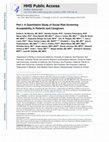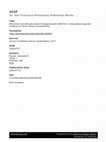Papers by Danielle Hessler

Chronic Stress
Background Mothers and their children demonstrate dyadic synchrony of hypothalamic–pituitary–adre... more Background Mothers and their children demonstrate dyadic synchrony of hypothalamic–pituitary–adrenal (HPA) axis function, likely influenced by shared genetic or environmental factors. Although evidence has shown that chronic stress exposure has physiologic consequences for individuals—including on the HPA axis—minimal research has explored how unmet social needs such as food and housing instability may be associated with chronic stress and HPA axis synchrony in mother–child dyads. Methods We conducted a secondary analysis of data from 364 mother–child dyads with low-income recruited during a randomized trial conducted in an urban pediatric clinic. We used latent profile analysis (LPA) to identify subgroups based on naturally occurring patterns of within-dyad hair cortisol concentration (HCC). A logistic regression model predicted dyadic HCC profile membership as a function of summative count of survey-reported unmet social needs, controlling for demographic and health covariates. Re...

International Journal of Environmental Research and Public Health
While there is evidence that access to nature and parks benefits pediatric health, it is unclear ... more While there is evidence that access to nature and parks benefits pediatric health, it is unclear how low-income families living in an urban center acknowledge or prioritize access to parks. Methods: We conducted a study about access to parks by pediatric patients in a health system serving low-income families. Adult caregivers of pediatric patients completed a survey to identify and prioritize unmet social and economic needs, including access to parks. Univariate and multivariate analyses were conducted to explore associations between lack of access to parks and sociodemographic variables. We also explored the extent to which access to parks competed with other needs. Results: The survey was completed by 890 caregivers; 151 (17%) identified “access to green spaces/parks/playgrounds” as an unmet need, compared to 397 (45%) who endorsed “running out of food before you had money or food stamps to buy more”. Being at or below the poverty line doubled the odds (Odds ratio 1.96, 95% CI 1....
Health Services Research, 2020
Conclusions: Early analyses indicated reductions in ED visits and hospitalizations among homeless... more Conclusions: Early analyses indicated reductions in ED visits and hospitalizations among homeless WPC enrollees compared to the control group but not the other outcomes examined. Improvements in outcomes were likely due to pilot's effort to assess homeless patients' needs and linkages to housing and other needed social services.
Health Services Research, 2020

The Journal of the American Board of Family Medicine, 2021
Introduction: Collaborative goal setting and action-planning are key elements of self-management ... more Introduction: Collaborative goal setting and action-planning are key elements of self-management support for people with type 2 diabetes mellitus (T2DM), however little is known regarding action plan quality or correlation of quality in primary T2DM care. Methods: T2DM patients from 12 primary care sites participated in either: Connection to Health (CTH; 6 practices), consisting of a health survey followed by collaborative action planning, or Enhanced Engagement CTH (EE-CTH; 6 practices), including additional training in relationship building promoting patient engagement. Action plan quality was rated using an adapted version of the Goal-Setting Evaluation Tool for Diabetes (GET-D) (dual coding of 20%, inter-rater reliability [IRR] >80%). Associations with patient characteristics were examined using generalized linear mixed models adjusting for clustering by clinic and intervention arm. Results: With a mean score 6 standard deviation (SD) of 14.62 6 3.87 on a 0 to 20 scale (n = 725), overall action plan quality was moderate-high. Higher health literacy (b = 1.184, 95% CI, 0.326-2.041; P = .007), and having no social risks (b = 0.416; 95% CI, 0.062-0.770; P = .021) were associated with higher action plan quality, whereas sex, age, language, education level, depression, stress, and health distress were unrelated to quality (P value not significant). Higher quality was associated with greater patient confidence in the plan (b = 0.050; 95% CI, 0.016-0.084, P = .004). Conclusions: Although there was a considerable difference in action plan quality ratings, ratings did not systematically differ based on most patient demographic or mental health measures. Results suggest that action planning should be tailored to health literacy and social risks. Further research should examine associations between quality and longer-term clinical outcomes.

JAMA Network Open, 2020
IMPORTANCE Health care organizations are increasingly incorporating social risk screening into pa... more IMPORTANCE Health care organizations are increasingly incorporating social risk screening into patient care. Studies have reported wide variations in patients' interest in receiving health carebased assistance for identified social risks. However, no study to date has examined the factors associated with patients' interest in receiving assistance, including whether interest in receiving assistance varies based on specific patient demographic characteristics. Targeted research on this topic could improve the success of health care-based programs that offer social care services. OBJECTIVE To identify participant characteristics associated with interest in receiving health carebased social risk assistance. DESIGN, SETTING, AND PARTICIPANTS This cross-sectional study was conducted in 7 primary care clinics and 4 emergency departments in 9 US states between July 2, 2018, and February 13, 2019. A convenience sample of adult patients and adult caregivers of pediatric patients completed a screening survey that measured social risk factors and participants' interest in receiving assistance for identified social risks. Participants were randomly selected to receive 1 of 2 versions of the survey, which differed based on the order in which questions about social risks and interest in receiving assistance were presented. Multivariable logistic regression analyses were used to evaluate the associations between covariates and participants' interest in receiving assistance, stratified by social risk screening results. Data were analyzed from September 8, 2019, to July 30, 2020. EXPOSURES Social risk screening questions assessed risk factors comprising housing, food, transportation, utilities, and exposure to interpersonal violence. Additional questions assessed participants' interest in receiving assistance and their perspectives on health care-based social risk screening. MAIN OUTCOMES AND MEASURES Participant interest in receiving health care-based social risk assistance. RESULTS A total of 1021 adult participants with complete survey responses were included in the analysis. Of those, 709 of 1004 participants (70.6%) were female, and 544 of 1007 participants (54.0%) were aged 18 to 44 years. Overall, 353 of 662 participants (53.3%) with positive screening results for 1 or more social risk factors were interested in receiving assistance, whereas 31 of 359 participants (8.6%) with negative screening results for all social risks were interested in receiving assistance. Participants with positive screening results for 1 or more social risk factors had a higher likelihood of being interested in receiving assistance if they answered the question about interest in receiving assistance before they answered the questions about social risk factors (adjusted odds ratio [aOR], 1.48; 95% CI, 1.05-2.07), had positive screening results for a higher number of social risk factors (aOR, 2.40; 95% CI, 1.68-3.42), reported lower household income levels (aOR, 7.78; 95% CI, (continued) Key Points Question Are specific social risk factors associated with patients' interest in receiving health care-based social risk assistance? Findings In this cross-sectional study of 1021 adult patients and adult caregivers of pediatric patients, 53% of participants who had positive screening results for social risks were interested in receiving social risk assistance compared with 9% of participants who had negative screening results. Among those with positive screening results, interest in receiving assistance was higher among participants who answered the question about their interest in receiving assistance before answering the questions about social risks and among participants who had positive results for multiple risks, reported lower household income, and self-identified as having non-Hispanic Black ancestry. Meaning The study's findings suggest that understanding patients' perspectives regarding their interest in receiving social risk assistance may be an important consideration in the implementation of patient-centered social care interventions.

Diabetes Care, 2021
OBJECTIVE To explore associations between reductions in diabetes distress (DD) and improvements i... more OBJECTIVE To explore associations between reductions in diabetes distress (DD) and improvements in glycemic outcomes among adults with type 1 diabetes (T1D) in the context of a DD randomized clinical trial. RESEARCH DESIGN AND METHODS Adults with T1D (N = 301) participated in a two-arm trial aimed at reducing DD (DD-focused OnTrack group vs. education-oriented KnowIt group). Mean age was 45.1 years; mean baseline HbA1c was 8.8% (73 mmol/mol). Individuals were assessed at baseline and 9 months later on DD, self-care, HbA1c, and frequency of hypoglycemia. Structural equation models evaluated hypothesized pathways among changes in DD, self-care, and glycemic outcomes in the total sample and by intervention group. RESULTS Reductions in DD were significantly and independently associated with better self-care, including fewer missed insulin boluses, more frequent insulin adjustment, improved problem-solving skills, more blood glucose monitoring, and greater adoption of continuous glucose ...

JMIR Research Protocols, 2021
BackgroundConsistent and compelling evidence demonstrates that social and economic adversity has ... more BackgroundConsistent and compelling evidence demonstrates that social and economic adversity has an impact on health outcomes. In response, many health care professional organizations recommend screening patients for experiences of social and economic adversity or social risks—for example, food, housing, and transportation insecurity—in the context of care. Guidance on how health care providers can act on documented social risk data to improve health outcomes is nascent. A strategy recommended by the National Academy of Medicine involves using social risk data to adapt care plans in ways that accommodate patients’ social risks.ObjectiveThis study’s aims are to develop electronic health record (EHR)–based clinical decision support (CDS) tools that suggest social risk–informed care plan adaptations for patients with diabetes or hypertension, assess tool adoption and its impact on selected clinical quality measures in community health centers, and examine perceptions of tool usability ...
JAMA Network Open, 2020
IMPORTANCE Social and economic contexts shape children's short-and long-term health. Efforts to a... more IMPORTANCE Social and economic contexts shape children's short-and long-term health. Efforts to address contextual risk factors are increasingly incorporated into pediatric health care. OBJECTIVE To compare the effectiveness of 2 social risk-related interventions. DESIGN, SETTING, AND PARTICIPANTS This randomized clinical trial included English-and/or Spanish-speaking caregiver-child dyads recruited from a pediatric urgent care clinic nested in a large,

American Journal of Preventive Medicine, 2019
/SIREN19_DeMarchis.pdf. EWF is a consultant for Veta Health, which is a company that develops sof... more /SIREN19_DeMarchis.pdf. EWF is a consultant for Veta Health, which is a company that develops software for chronic disease management. Veta Health also supports HelpSteps, a system for connecting families to social services developed by EWF. In the future, it is possible that this technology will be sold commercially. If this were to occur, EWF and Boston Children's Hospital might receive financial benefits in the form of compensation. As in all research studies, the Boston Children's Hospital has taken steps designed to ensure that this potential for financial gain does not endanger research subjects or undercut the validity and integrity of the information learned by this research. The research published in this paper is not related to any of the above consulting work and was conducted prior EWF working with Veta Health. STL directed a Center for Medicare and Medicaid Innovation Health Care Innovation Award (1C1CMS330997-03) called CommunityRx. This award required development of a sustainable business model to support the model test after award funding ended. To this end, STL is founder and co-owner of NowPow, LLC. Neither the University of Chicago nor the University of Chicago Medicine is endorsing or promoting any NowPow entity or its business, products, or services. No other financial disclosures were reported by the authors of this paper.
The Journal of the American Board of Family Medicine, 2019
The above letter was referred to the author of the article in question, who offers the following ... more The above letter was referred to the author of the article in question, who offers the following reply.

Journal of Diabetes and its Complications, 2018
To identify and assess patient motivation to initiate or maintain behavior changes. Methods: Atti... more To identify and assess patient motivation to initiate or maintain behavior changes. Methods: Attitudinal statements were developed from structured patient interviews and translated into 18 survey items. Items were analyzed with exploratory factor analysis (EFA). Results: An EFA with 340 type 2 diabetes patients identified three areas of patient attitudes toward changing health behaviors: (1) willingness to make changes (3 items; α = 0.69), (2) perceived ability to make or maintain changes (3 items; α = 0.74), and (3) and feeling changes are worthwhile (3 items; α = 0.61). Greater perceived ability and feelings of worthwhileness were associated with positive psychosocial and behavioral management indicators. All three areas were associated with confidence and attitudes toward making a specific behavioral change (e.g., improve diet). Conclusions: MATCH is an internally consistent and valid 9-item scale that provides a profile of factors influencing motivation that can be used in clinical and research settings.

Diabetes Therapy, 2019
Introduction: EMOTION was a multinational, noninterventional study surveying current insulin-usin... more Introduction: EMOTION was a multinational, noninterventional study surveying current insulin-using adults with type 2 diabetes mellitus (T2D) who were initially reluctant to begin insulin treatment. In this Japanese population subanalysis of EMOTION, we identify the frequency and level of helpfulness of healthcare provider (HCP) actions, and we analyze life events ('actions/events') that assist T2D patients with psychological insulin resistance in the decision to initiate insulin. Methods: Participants were selected from Survey Sampling International and their local partners' market research panels in Japan. Quantitative surveys were administered between December 2016 and August 2017 to patients who met the study criteria. Participants were asked whether 45 actions/events occurred, and to rate the level of helpfulness of the actions/events in contributing to their decision to initiate insulin. Results: Among the 594 eligible participating adults in the EMOTION study, 99 were from Japan. Despite initial reluctance to begin insulin treatment, 80.8% of the Japanese participants immediately commenced insulin. Practical demonstrations by HCPs on how to use insulin were rated by participants as most helpful. Examples of such practical demonstrations, reported as helping moderately or a lot, were 'HCP walked patient through the process of exactly how to take insulin' (82.8%), 'HCP showed an insulin pen' (79.7%), and 'HCP helped patient to see how simple it was to inject insulin' (79.1%). Conclusion: This study identifies actions that HCPs can use to assist Japanese patients in deciding whether to initiate insulin. These findings may aid the development of clinical interventions addressing reluctance to begin insulin treatment among Japanese patients with T2D.

Current Diabetes Reports, 2019
Purpose of Review Patient social and economic risk information can guide diabetes care through so... more Purpose of Review Patient social and economic risk information can guide diabetes care through social risk-targeted care (directly intervening on social risk factors) or social risk-informed care (modifying or tailoring care to accommodate social risks). We review evidence supporting these approaches and highlight critical gaps in the current evidence. Recent Findings Literature is scarce on isolated social care interventions and the impact on glycemic control is unclear, while blended social-behavioral interventions more consistently point to reductions in HbA1c. Social risk-informed care naturally occurs at low rates, yet holds potential to improve care. Summary Momentum is building around programs designed to intervene on social risk factors and/or to contextualize care based on social context. Future work will need to isolate the impacts of these programs, clarify the pathways through which social care programs can improve outcomes, and identify provider barriers and facilitators to using social risk information in care. Keywords Social risk. Social determinants of health. Contextualized care. Social intervention This article is part of the Topical Collection on Psychosocial Aspects

The Journal of the American Board of Family Medicine, 2019
Background: A recent regional study found lower burnout among primary care clinicians who perceiv... more Background: A recent regional study found lower burnout among primary care clinicians who perceived that their clinic had greater capacity to meet patients' social needs. We aimed to more comprehensively investigate the association between clinic capacity to address social needs and burnout by using national data that included a more representative sample of family physicians and a more comprehensive set of practice-level variables that are potential confounders of an association between clinic social needs capacity and burnout. Methods: We conducted a cross-sectional analysis of 1298 family physicians in ambulatory primary care settings who applied to continue certification with the American Board of Family Medicine in 2016. Logistic regression was used to test associations between physician and clinic characteristics, perceived clinic social needs capacity, and burnout. Results: A total of 27% of family physicians reported burnout. Physicians with a high perception of their clinic's ability to meet patients' social needs were less likely to report burnout (adjusted odds ratio [OR], 0.66; 95% confidence interval [CI], 0.47-0.91). Physicians who reported high clinic capacity to address patients' social needs were more likely to report having a social worker (adjusted OR, 2.16; 95% CI, 1.44-3.26) or pharmacist (adjusted OR, 1.73; 95% CI, 1.18-2.53) on their care team and working in a patient-centered medical home (adjusted OR, 1.65; 95% CI, 1.24-2.21). Conclusion: Efforts to reduce primary care physician burnout may be furthered by addressing structural issues, such as improving capacity to respond to patients' social needs in addition to targeting other modifiable burnout risks.

Diabetes care, Sep 1, 2018
To compare the effectiveness of two interventions to reduce diabetes distress (DD) and improve gl... more To compare the effectiveness of two interventions to reduce diabetes distress (DD) and improve glycemic control among adults with type 1 diabetes (T1D). Individuals with T1D ( = 301) with elevated DD and HbA were recruited from multiple settings and randomly assigned to OnTrack, an emotion-focused intervention, or to KnowIt, an educational/behavioral intervention. Each group attended a full-day workshop plus four online meetings over 3 months. Assessments occurred at baseline and 3 and 9 months. Primary and secondary outcomes were change in DD and change in HbA, respectively. With 12% attrition, both groups demonstrated dramatic reductions in DD (effect size = 1.06; 78.4% demonstrated a reduction of at least one minimal clinically important difference). There were, however, no significant differences in DD reduction between OnTrack and KnowIt. Moderator analyses indicated that OnTrack provided greater DD reduction to those with initially poorer cognitive or emotion regulation skills...

Journal of health care for the poor and underserved, 2018
Primary care physicians (PCP) experience high rates of professional burnout. These symptoms may b... more Primary care physicians (PCP) experience high rates of professional burnout. These symptoms may be magnified in underserved populations. This study explores relationships between clinic capacity to address patients' social needs (SN) and PCP burnout. We conducted a cross-sectional survey of PCPs from three delivery systems in San Francisco. Surveys included three components of burnout, measured by the Maslach Burnout Inventory (MBI) and a four-item instrument exploring attitudes, confidence, individual skills and organizational capacity to address patients' SN. Provider perception of higher clinic capacity to address patients' SN was the strongest independent predictor of lower burnout. Providers who perceived high clinic capacity and resources to address SN reported significantly greater professional efficacy (p <.01), lower emotional exhaustion (p <.05), and lower cynicism (p <.05). Provider perceptions of greater clinic capacity to address SN are significantl...
The American journal of emergency medicine, Jan 16, 2018

Health affairs (Project Hope), Nov 1, 2016
Recent efforts in medical settings to identify social determinants of health have focused primari... more Recent efforts in medical settings to identify social determinants of health have focused primarily on screening for the purpose of improving care for individual patients and getting standardized data into electronic health records (EHRs). Relatively little attention has been given to processes needed to extract data on social determinants of health out of medical records with adequate validity and efficiency to facilitate analysis across individual encounters to inform population health efforts relevant to the health care sector. In this article we describe the rationale for extracting data on social determinants of health from EHRs, including the potential influence of aggregated data on quality improvement activities and health care payment reform. We then discuss opportunities and challenges to pulling these data from EHRs to enable population-level applications, focusing on the International Statistical Classification of Diseases and Related Health Problems, Tenth Revision, as ...

Journal of General Internal Medicine, 2016
Despite substantial evidence documenting the social patterning of disease, relatively little info... more Despite substantial evidence documenting the social patterning of disease, relatively little information is available on how the health care system can best intervene on social determinants to impact individual and population health. Announced in January 2016, the Centers for Medicare and Medicaid Innovation's (CMMI) Accountable Health Communities (AHC) initiative provides an important opportunity to improve the evidence base around integrated social and medical care delivery. To maximize learning from this largescale demonstration, comprehensive evaluation efforts should focus on effectiveness and implementation research by supporting local, regional, and national studies across a range of outcomes. Findings from this demonstration could transform how, when, and which patients' health-related social needs are addressed within the health care delivery system. Such findings would strongly complement other initiatives to address social factors outside of health care.










Uploads
Papers by Danielle Hessler